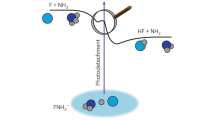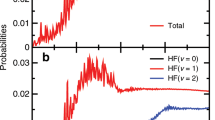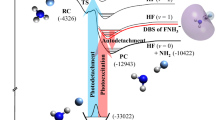Abstract
The transition state governs how chemical bonds form and cleave during a chemical reaction and its direct characterization is a long-standing challenge in physical chemistry. Transition state spectroscopy experiments based on negative-ion photodetachment provide a direct probe of the vibrational structure and metastable resonances that are characteristic of the reactive surface. Dynamical resonances are extremely sensitive to the topography of the reactive surface and provide an exceptional point of comparison with theory. Here we study the seven-atom F + CH3OH → HF + CH3O reaction using slow photoelectron velocity-map imaging spectroscopy of cryocooled CH3OHF− anions. These measurements reveal spectral features associated with a manifold of vibrational Feshbach resonances and bound states supported by the post-transition state potential well. Quantum dynamical calculations yield excellent agreement with the experimental results, allow the assignment of spectral structure and demonstrate that the key dynamics of complex bimolecular reactions can be captured with a relatively simple theoretical framework.
This is a preview of subscription content, access via your institution
Access options
Access Nature and 54 other Nature Portfolio journals
Get Nature+, our best-value online-access subscription
$29.99 / 30 days
cancel any time
Subscribe to this journal
Receive 12 print issues and online access
$259.00 per year
only $21.58 per issue
Buy this article
- Purchase on Springer Link
- Instant access to full article PDF
Prices may be subject to local taxes which are calculated during checkout



Similar content being viewed by others
References
Herschbach, D. R. Reactive collisions in crossed molecular beams. Discuss. Faraday Soc. 33, 149–161 (1962).
Lee, Y. T., McDonald, J. D., LeBreton, P. R. & Herschbach, D. R. Molecular beam reactive scattering apparatus with electron bombardment detector. Rev. Sci. Instrum. 40, 1402–1408 (1969).
Levine, R. D. Molecular Reaction Dynamics (Cambridge Univ. Press, 2005).
Eyring, H. The activated complex in chemical reactions. J. Chem. Phys. 3, 107–115 (1935).
Truhlar, D. G., Garrett, B. C. & Klippenstein, S. J. Current status of transition-state theory. J. Phys. Chem. 100, 12771–12800 (1996).
Guo, H. & Liu, K. Control of chemical reactivity by transition-state and beyond. Chem. Sci. 7, 3992–4003 (2016).
Polanyi, J. C. & Zewail, A. H. Direct observation of the transition state. Acc. Chem. Res. 28, 119–132 (1995).
Zare, R. N. Laser control of chemical reactions. Science 279, 1875–1879 (1998).
Yang, T. et al. Extremely short-lived reaction resonances in Cl + HD (v = 1) → DCl + H due to chemical bond softening. Science 347, 60–63 (2015).
Liu, K. Vibrational control of bimolecular reactions with methane by mode, bond, and stereoselectivity. Annu. Rev. Phys. Chem. 67, 91–111 (2016).
Neumark, D. M. Probing the transition state with negative ion photodetachment: experiment and theory. Phys. Chem. Chem. Phys. 7, 433–442 (2005).
Kim, J. B. et al. Spectroscopic observation of resonances in the F + H2 reaction. Science 349, 510–513 (2015).
Ervin, K. M., Ho, J. & Lineberger, W. C. A study of the singlet and triplet states of vinylidene by photoelectron spectroscopy of H2CC−, D2CC− and HDCC−. Vinylidene–acetylene isomerization. J. Chem. Phys. 91, 5974–5992 (1989).
Wenthold, P. G., Hrovat, D. A., Borden, W. T. & Lineberger, W. C. Transition-state spectroscopy of cyclooctatetraene. Science 272, 1456–1459 (1996).
Osterwalder, A., Nee, M. J., Zhou, J. & Neumark, D. M. High resolution photodetachment spectroscopy of negative ions via slow photoelectron imaging. J. Chem. Phys. 121, 6317–6322 (2004).
Neumark, D. M. Slow electron velocity-map imaging of negative ions: applications to spectroscopy and dynamics. J. Phys. Chem. A 112, 13287–13301 (2008).
Hock, C., Kim, J. B., Weichman, M. L., Yacovitch, T. I. & Neumark, D. M. Slow photoelectron velocity-map imaging spectroscopy of cold negative ions. J. Chem. Phys. 137, 244201 (2012).
Weichman, M. L., DeVine, J. A., Levine, D. S., Kim, J. B. & Neumark, D. M. Isomer-specific vibronic structure of the 9-, 1-, and 2-anthracenyl radicals via slow photoelectron velocity-map imaging. Proc. Natl Acad. Sci. USA 113, 1698–1705 (2016).
DeVine, J. A. et al. Non-adiabatic effects on excited states of vinylidene observed with slow photoelectron velocity-map imaging. J. Am. Chem. Soc. 138, 16417–16425 (2016).
Bradforth, S. E., Arnold, D. W., Metz, R. B., Weaver, A. & Neumark, D. M. Spectroscopy of the transition state: hydrogen abstraction reactions of fluorine. J. Phys. Chem. 95, 8066–8078 (1991).
Ray, A. W., Agarwal, J., Shen, B. B., Schaefer, H. F. & Continetti, R. E. Energetics and transition-state dynamics of the F + HOCH3 → HF + OCH3 reaction. Phys. Chem. Chem. Phys. 18, 30612–30621 (2016).
Schatz, G. C., Bowman, J. M. & Kuppermann, A. Exact quantum, quasiclassical, and semiclassical reaction probabilities for the collinear F + H2 → FH + H reaction. J. Chem. Phys. 63, 674–684 (1975).
Wyatt, R. E. & Redmon, M. J. Quantum-mechanical differential reaction cross sections for the F + H2 (v = 0) → FH (v′ = 2,3) + H reaction. Chem. Phys. Lett. 96, 284–288 (1983).
Schatz, G. C. Detecting resonances. Science 288, 1599–1600 (2000).
Zare, R. N. Resonances in reaction dynamics. Science 311, 1383–1385 (2006).
Liu, K. Quantum dynamical resonances in chemical reactions: from A + BC to polyatomic systems. Adv. Chem. Phys. 149, 1–46 (2012).
Neumark, D. M., Wodtke, A. M., Robinson, G. N., Hayden, C. C. & Lee, Y. T. Molecular beam studies of the F + H2 reaction. J. Chem. Phys. 82, 3045–3066 (1985).
Skodje, R. T. et al. Observation of a transition state resonance in the integral cross section of the F + HD reaction. J. Chem. Phys. 112, 4536–4552 (2000).
Qiu, M. et al. Observation of Feshbach resonances in the F + H2 → HF + H reaction. Science 311, 1440–1443 (2006).
Ren, Z., Sun, Z., Zhang, D. & Yang, X. A review of dynamical resonances in A + BC chemical reactions. Rep. Prog. Phys. 80, 026401 (2017).
Russell, C. L. & Manolopoulos, D. E. How to observe the elusive resonances in F + H2 reactive scattering. Chem. Phys. Lett. 256, 465–473 (1996).
Garand, E., Zhou, J., Manolopoulos, D. E., Alexander, M. H. & Neumark, D. M. Nonadiabatic interactions in the Cl + H2 reaction probed by ClH2− and ClD2− photoelectron imaging. Science 319, 72–75 (2008).
Waller, I. M., Kitsopoulos, T. N. & Neumark, D. M. Threshold photodetachment spectroscopy of the I + HI transition-state region. J. Phys. Chem. 94, 2240–2242 (1990).
Otto, R. et al. Imaging dynamics on the F + H2O → HF + OH potential energy surfaces from wells to barriers. Science 343, 396–399 (2014).
Westermann, T. et al. Resonances in the entrance channel of the elementary chemical reaction of fluorine and methane. Angew. Chem. Int. Ed. 53, 1122–1126 (2014).
Active Thermochemical Tables Values based on v. 1.118 of the Thermochemical Network (Argonne National Laboratory 2015); http://ATcT.anl.gov
Feng, H., Randall, K. R. & Schaefer, H. F. Reaction of a fluorine atom with methanol: potential energy surface considerations. J. Phys. Chem. A 119, 1636–1641 (2015).
Glauser, W. A. & Koszykowski, M. L. Anomalous methoxy radical yields in the fluorine + methanol reaction. 2. Theory. J. Phys. Chem. 95, 10705–10713 (1991).
Jodkowski, J. T., Rayez, M.-T., Rayez, J.-C., Bérces, T. & Dóbé, S. Theoretical study of the kinetics of the hydrogen abstraction from methanol. 1. Reaction of methanol with fluorine atoms. J. Phys. Chem. A 102, 9219–9229 (1998).
Meier, U., Grotheer, H. H. & Just, T. Temperature dependence and branching ratio of the CH3OH + OH reaction. Chem. Phys. Lett. 106, 97–101 (1984).
Wickramaaratchi, M. A., Setser, D. W., Hildebrandt, H., Körbitzer, B. & Heydtmann, H. Evaluation of HF product distributions deduced from infrared chemiluminescence. II. F atom reactions. Chem. Phys. 94, 109–129 (1985).
Khatoon, T. & Hoyermann, K. The reactions of fluorine atoms with normal and deuterated methanols. Ber. Bunsen-Ges. Phys. Chem. 92, 669–673 (1988).
Durant, J. L. Anomalous methoxy radical yields in the fluorine + methanol reaction. 1. Experiment. J. Phys. Chem. 95, 10701–10704 (1991).
Dóbé, S., Bérces, T., Temps, F., Wagner, H. G. & Ziemer, H. Formation of methoxy and hydroxymethyl free radicals in selected elementary reactions. 25th Symp. Int. Combust. Proc. 25, 775–781 (1994).
Wladkowski, B. D., East, A. L. L., Mihalick, J. E., Allen, W. D. & Brauman, J. I. The proton-transfer surface of CH3OHF−. J. Chem. Phys. 100, 2058–2088 (1994).
Sun, L., Song, K., Hase, W. L., Sena, M. & Riveros, J. M. Stationary points for the OH− + CH3F → CH3OH + F− potential energy surface. Int. J. Mass Spectrom. 227, 315–325 (2003).
Gonzales, J. M. et al. Definitive ab initio studies of model SN2 reactions CH3X + F− (X = F, Cl, CN, OH, SH, NH2, PH2). Chem. Eur. J. 9, 2173–2192 (2003).
Knizia, G., Adler, T. B. & Werner, H.-J. Simplified CCSD(T)-F12 methods: theory and benchmarks. J. Chem. Phys. 130, 054104 (2009).
Jiang, B., Li, J. & Guo, H. Potential energy surfaces from high fidelity fitting of ab initio points: the permutation invariant polynomial-neural network approach. Int. Rev. Phys. Chem. 35, 479–506 (2016).
Li, J., Li, Y. & Guo, H. Covalent nature of X···H2O (X = F, Cl, and Br) interactions. J. Chem. Phys. 138, 141102 (2013).
Manz, J., Meyer, R., Pollak, E. & Romelt, J. A new possibility of chemical bonding. vibrational stabilization of IHI. Chem. Phys. Lett. 93, 184–187 (1982).
Manz, J., Meyer, R. & Schor, H. H. R. Interplay of vibrational and van der Waals type bonding. J. Chem. Phys. 80, 1562–1568 (1984).
Fleming, D. G., Manz, J., Sato, K. & Takayanagi, T. Fundamental change in the nature of chemical bonding by isotopic substitution. Angew. Chem. Int. Ed. 53, 13706–13709 (2014).
Levine, R. D. & Wu, S. F. Resonances in reactive collisions: computational study of the H + H2 collision. Chem. Phys. Lett. 11, 557–561 (1971).
Ma, J. & Guo, H. Reactive and nonreactive Feshbach resonances accessed by photodetachment of FH2O−. J. Phys. Chem. Lett. 6, 4822–4826 (2015).
Wigner, E. P. On the behavior of cross sections near thresholds. Phys. Rev. 73, 1002–1009 (1948).
Even, U., Jortner, J., Noy, D., Lavie, N. & Cossart-Magos, C. Cooling of large molecules below 1 K and He clusters formation. J. Chem. Phys. 112, 8068–8071 (2000).
Eppink, A. T. J. B. & Parker, D. H. Velocity map imaging of ions and electrons using electrostatic lenses: application in photoelectron and photofragment ion imaging of molecular oxygen. Rev. Sci. Instrum. 68, 3477–3484 (1997).
Guo, H. A time-independent theory of photodissociation based on polynomial propagation. J. Chem. Phys. 108, 2466–2472 (1998).
Acknowledgements
This work is funded by the US Air Force Office of Scientific Research (Grants no. FA9550-16-1-0097 to D.M.N. and no. FA9550-15-1-0305 to H.G.), and the National Natural Science Foundation of China (Contracts no. 21573027 to J.L. and no. 91441107 to J.M.). M.L.W. thanks the National Science Foundation for a graduate research fellowship.
Author information
Authors and Affiliations
Contributions
The experimental research was conceived and supervised by D.M.N. The experiments were carried out by M.L.W., J.A.D. and M.C.B. Experimental data analysis and interpretation was performed by M.L.W. Theoretical calculations were conceived by J.L., J.M. and H.G. and performed by J.L., L.G. and J.M. The paper was written by M.L.W., with the theoretical sections contributed by J.L., J.M. and H.G. All of the authors contributed to discussions about the results and manuscript.
Corresponding authors
Ethics declarations
Competing interests
The authors declare no competing financial interests.
Supplementary information
Supplementary information
Supplementary information (PDF 898 kb)
Rights and permissions
About this article
Cite this article
Weichman, M., DeVine, J., Babin, M. et al. Feshbach resonances in the exit channel of the F + CH3OH → HF + CH3O reaction observed using transition-state spectroscopy. Nature Chem 9, 950–955 (2017). https://doi.org/10.1038/nchem.2804
Received:
Accepted:
Published:
Issue Date:
DOI: https://doi.org/10.1038/nchem.2804
This article is cited by
-
Probing the activated complex of the F + NH3 reaction via a dipole-bound state
Nature Communications (2024)
-
Rehybridization dynamics into the pericyclic minimum of an electrocyclic reaction imaged in real-time
Nature Communications (2023)
-
Observation of resonances in the transition state region of the F + NH3 reaction using anion photoelectron spectroscopy
Nature Chemistry (2023)
-
Direct observation of a Feshbach resonance by coincidence detection of ions and electrons in Penning ionization collisions
Nature Communications (2020)
-
Mode specificity of a multi-channel reaction prototype: F + CH3OH → HF + CH3O/CH2OH
Theoretical Chemistry Accounts (2020)



